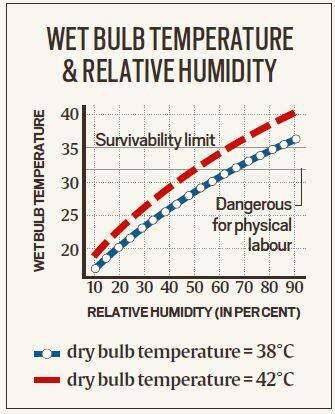What is a wet bulb temperature? A Crucial Metric 24
Wet Bulb Temperature
Important information regarding air temperature and humidity is provided by the concept of wet bulb temperature, which is fundamental to meteorology and environmental research. In contrast to the widely recognized dry bulb temperature, which is the air’s temperature as determined by a conventional thermometer, wet bulb temperature considers evaporation’s cooling effect.
Thermal comfort, controlling ambient moisture, and the effectiveness of cooling systems all depend on the wet bulb temperature. Numerous factors, such as humidity, moisture, wind speed, dry bulb temperature, and more, are covered in this article about wet bulb temperature. Thermal comfort indices, air conditioning, and psychrometric computations will also be covered.

A thermometer is used to measure it; the bulb is exposed to airflow and has a wetted wick wrapped around it.
The thermometer reads lower than the dry bulb temperature as a result of the water absorbing heat during its evaporation.
Since it closely resembles the temperature experienced by human skin and captures the body’s ability to cool itself through perspiration, this measurement is significant. High humidity levels can seriously impede sweat evaporation and result in dangerously high levels of heat stress, as shown by high wet bulb temperatures.
For a number of purposes, such as weather forecasting, HVAC system design, and occupational safety in hot environments, it is essential to measure the wet bulb temperature. The significance of wet bulb temperature in evaluating human comfort and health hazards increases as climate change persists in raising the frequency and intensity of heatwaves.
With 100% relative humidity (the air is at the saturation line), the wet bulb temperature is always lower than the dry bulb temperature but remains constant. Human health is seriously endangered at wet-bulb temperatures of 31 °C and above, and over 6 hours is not feasible at temperatures of 35 °C.
In this article, we will learn in detail about wet bulb humidity, humidity, moisture, wind speed, dry bulb temperature, wet bulb due point, wet bulb heat index, psychrometric calculations, atmospheric moisture, air conditioning, thermal comfort index, dew point temperature, and evaporative cooling.
What is the wet bulb temperature?
The lowest temperature that can be reached using evaporative cooling is known as the wet bulb temperature. The thermometer’s bulb is wrapped in a wet wick and exposed to air flow to measure it. The temperature reading drops below the dry bulb temperature as a result of heat being absorbed by the wick’s evaporating water.
Key Factors Affecting Wet Bulb Temperature.
The quantity of water vapor in the atmosphere is known as humidity. Lower evaporation from higher humidity results in a lower temperature differential between wet and dry bulbs.
Wet-bulb temperature and humidity are influenced by moisture, which is the actual amount of water in the air.
Wind Speed: Better evaporation results from increased airflow, which may result in a drop in the temperature of the wet bulb.
Follow our Digiknowledge.co.in page for the latest updates about technology, bikes, cars, sports, lifestyle, and many more.
How Do Dry Bulb and Wet Bulb Temperatures Differ?
An ordinary thermometer reading for the air is known as the “dry bulb temperature.” The air’s moisture content is not taken into account.
The wet bulb temperature, on the other hand, accounts for evaporation’s cooling influence and offers a more complete picture of the surroundings.
Atmospheric Moisture and Evaporative Cooling
The control of climate and weather patterns is greatly influenced by atmospheric moisture. Water evaporation is the natural cooling mechanism that lowers the air temperature through evaporative cooling. Cooling systems frequently employ this idea, particularly in arid regions.
What is the role of air conditioning in managing atmospheric moisture?
Enhancing home comfort and air quality, air conditioning systems eliminate surplus moisture in addition to cooling the air. Efficiency in air conditioning system design is aided by knowledge of psychrometric characteristics and wet bulb temperature.
Conclusion
To manage thermal comfort, design effective HVAC systems, and ensure safety in a variety of conditions, it is essential to comprehend wet bulb temperature and associated concepts. Making well-informed judgments to improve our comfort and well-being requires a thorough assessment of variables like humidity, wetness, wind speed, and dry bulb temperature.
What is the wet bulb temperature in India?
35 degrees Celsius
What is a good wet bulb temperature?
The lowest temperature that may be attained by the evaporation of water alone in the current environmental conditions is known as the wet-bulb temperature. When the temperature drops below 32 °C (90 °F) or when the heat index reaches 55 °C (131 °F), even those who are acclimated to extreme heat find it impossible to engage in regular outside activities.
What is the difference between dry bulb and wet bulb temperatures?
Wet bulb temperature takes evaporation’s cooling effect into account, whereas dry bulb temperature only measures the air’s temperature.
Why is the wet bulb temperature important for heat stress assessment?
The measurement of the wet bulb temperature is important because it is a good indicator of the body’s ability to regulate its temperature through perspiration.
What role do psychrometric calculations play in HVAC design?
In order to achieve the best possible thermal comfort and energy efficiency, psychometry calculations aid in the measurement of air qualities and the design of effective HVAC systems.
We can better control our surroundings and guarantee comfort and safety in a variety of situations if we comprehend these ideas.
Why does the wet bulb become colder?
The temperature at which air can be cooled through evaporative cooling is known as the wet bulb temperature. Using a thermometer wrapped in a wick soaked in water or another porous material, one can measure the temperature of the wet bulb. The web bulb temperature drops, and the moisture evaporation rate increases with dry air.




